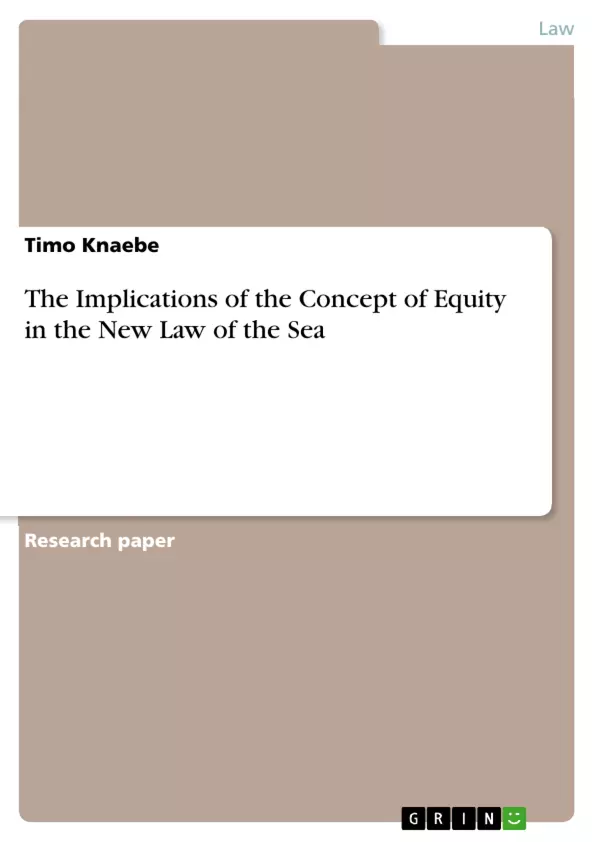Equity as a legal concept is a direct emanation of the idea of justice. It was however a long time, before this understanding broke way in municipal law, let alone that it became accepted by a majority in Public International Law, as the lawyers [in England] had a maxim that they would tolerate a ‘mischief’ [a failure of substantial justice in a particular case] rather than an ‘inconvenience’ [a breach of legal principle]. The parties to the case were however mostly not satisfied with such ‘inconvenience’ resulting from the ‘hard nosed’ municipal Common Law and started to seek redress from a higher authority — in this case the King of England. This (royal) remedy is based on the concept of ‘Equity,’ which — as understood in this paper — was applied to correct unjust outcomes and referred to considerations of fairness, and reasonableness. Eventually, the foremost municipal concept of Equity found entry into international jurisprudence. However, mostly civil law countries — whose approach towards Equity was and is more reluctant — were challenging this understanding, arguing that the Court “should work on the basis of existing rights,” in Public International Law a distinction of different ‘Equities’ was developed. As will be shown, the usage of some of these ‘Equities’ is highly controversial, whereas others are today nearly commonly accepted as part of today’s Public International Law.
Inhaltsverzeichnis (Table of Contents)
- Chapter One: Introduction
- 1.1 Aim of Study
- 1.2 Significance of Examination
- 1.3 Literature Review
- 1.4 Methodology
- Chapter Two: Development of the Principle of Equity
- Chapter Three: The Usage of Equity in General Public International Law
- 3.1 Equity Intra Legem
- 3.2 Equity Praeter Legem
- 3.3 Equity Contra Legem
- 3.4 Interim Summary
- Chapter Four: Equity in the Decisions of International Judicial Bodies
- 4.1 North Sea Continental Shelf Case
- 4.2 Continental Shelf Arbitration, France v. United Kingdom
- 4.3 Fisheries Jurisdiction Case
- 4.4 Continental Shelf Case, Tunisia v. Libyan Arab Jamahiriya
- 4.5 Continental Shelf Case, Libyan Arab Jamahiriya v. Malta
- 4.6 Burkina Faso v. Republic of Mali Case
- 4.7 Interim Summary
- Chapter Five: Equity in the 1982 LOS Convention
- 5.1 Preamble, 1982 LOS Convention
- 5.2 Art. 59, 1982 LOS Convention
- 5.3 Art. 69 (1), 1982 LOS Convention
- 5.4 Arts. 74 (1), 83 (2), 1982 LOS Convention
- 5.5 Art. 140 (2), 1982 LOS Convention
- Chapter Six: Equity in the 1982 LOS Convention
- A Summary
- Chapter Seven: Recent Developments
Zielsetzung und Themenschwerpunkte (Objectives and Key Themes)
This thesis investigates the implications of the concept of equity on the law of the sea. It traces the historical development of the concept from its origins in English municipal law to its application in contemporary international law, particularly within the framework of the 1982 United Nations Convention on the Law of the Sea (UNCLOS). The analysis delves into the doctrinal debate surrounding the role of equity in public international law, specifically the tension between positivism and natural law perspectives. The study examines the different forms of equity, including equity intra legem, equity praeter legem, and equity contra legem, exploring their controversial nature and their impact on international jurisprudence.
- The historical development and evolution of the concept of equity in both municipal and international law.
- The various forms and applications of equity in public international law, including its controversial aspects.
- The implications of equity on the 1982 UNCLOS and the subsequent developments in international law of the sea.
- The doctrinal debate surrounding the role of equity in public international law, particularly the tension between positivism and natural law.
- The impact of equity on the legal system and its influence on decision-making by international judicial bodies.
Zusammenfassung der Kapitel (Chapter Summaries)
Chapter One introduces the subject of the thesis, outlining its objectives, significance, literature review, and methodology. Chapter Two explores the historical development of the principle of equity, tracing its origins in English municipal law and its subsequent evolution. Chapter Three delves into the different forms and applications of equity in general public international law, discussing the controversial aspects and the diverse perspectives on its role. Chapter Four examines the use of equity in various decisions of international judicial bodies, highlighting key cases such as the North Sea Continental Shelf Case, the Continental Shelf Arbitration, France v. United Kingdom, and the Fisheries Jurisdiction Case. Chapter Five focuses on the implications of equity on the 1982 UNCLOS, analyzing its provisions and the impact of equity on specific articles within the convention. Chapter Six provides a summary of the arguments and findings of the preceding chapters, summarizing the role of equity in the context of the 1982 UNCLOS.
Schlüsselwörter (Keywords)
The central keywords of this work revolve around the concept of equity, its application within public international law, and its specific relevance to the law of the sea. Key themes include the 1982 UNCLOS, international judicial decisions, the doctrinal debate surrounding equity, and the contrasting perspectives of positivism and natural law. The analysis explores the various forms of equity, including equity intra legem, equity praeter legem, and equity contra legem, examining their implications for international legal frameworks and the resolution of disputes. The thesis also considers the economic and political dimensions of equity's application, recognizing its potential impact on global power dynamics and resource distribution.
- Citar trabajo
- LL.M. Timo Knaebe (Autor), 2006, The Implications of the Concept of Equity in the New Law of the Sea, Múnich, GRIN Verlag, https://www.grin.com/document/59321



